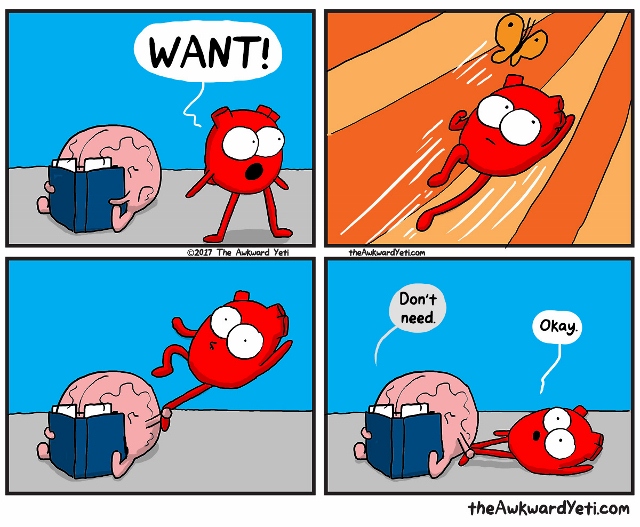“Follow your heart, but take your brain with you.”
Growing up, I was always a kid who followed my heart. I tried hip-hop dance because I loved the way it made me feel. I participated in my volleyball league until my “heart” was no longer in it, even though all of my friends remained on the team.
In high school, I took all of the classes that I was sincerely passionate about, which led me to travel alone through Mexico because learning and experiencing new cultures made my heart sing!
For me, following my heart always felt easy; and if fearful or “what if” thoughts came up along the way, they were simply ignored and I continued on.
It was not until my mid 20s, after “following my heart” and taking a teaching job in an international school in Asia, that I realized I was lacking something large in all of my decisions: my mind.
After spending several months in a foreign place, far from anything or anyone I knew, I realized this time that my heart’s desire to live and teach in Asia was actually quite fleeting and it did not come from a harmonious, whole-body, inner place.
And that was because that place no longer existed within me; I had lost it working through several master’s degrees, working full-time, and going and doing so much until I could no longer do anymore.
Later, I realized that many of the patterns and beliefs I held about myself and the world were not aligned with the supposed heart-centered actions I was taking.
It would take me several more years of going the long route, repatterning my inner belief system, and taking small, aligned actions and decisions to better understand why “following my heart” would never have the same meaning for me.
The Heart-Mind
In Japan, this concept is explained in a single word: kokoro. Kokoro (in English, the heart-mind) is defined as one’s center or core, and does not necessarily refer to the anatomical heart, but the harmonious relationship between one’s heart, mind, thoughts, emotions, spirit, and body.
Shohaku Okumura, a Japanese Zen priest living in the United States, defines kokoro: “Originally, kokoro referred to the beat of the heart, which was considered to be the essential organ of life and the source of all activities. By extension, kokoro refers to all human activities affecting the outside world through intention, emotion, and intellect.”
Kokoro, then, has three basic meanings: the heart and its functions, the mind and its functions, and our center, or spiritual essence.
In Japan, if you have a strong kokoro, ultimately, it means that you are centered. Your relationship with the outer world directly reflects your inner being, and you often signal to others a state of balance, contentment, emotional stability, confidence, and readiness.
In China, they have a word with a similar definition: xin. This Chinese character has a range of meanings including our heart organ, the general “heart space,” our mind, feelings, intention, and our center.
How the Heart Interacts with the Brain
To me, it is interesting that in the English language, we have completely different words to define the heart and the mind. We have no word that combines both meanings.
Maybe this is where our problem lies. Because of our language, much of our Western culture does not recognize the deep, interconnected relationship between our hearts, bodies, spirits, and our minds.
However, it has been scientifically proven that our heart is in constant communication with our brain, continuously sending it signals that have a large influence on many parts of our nervous system, including most glands and organs.
It is also proven that the signals sent by the heart to the brain have profound effects on specific areas in our brain, such as the thalamus, hypothalamus, and amygdala, which play an important role in determining our perceptions, thought processes, and our emotional state.
When our emotional state is one of inner peace, gratitude, or other positive feelings, the brain receives signals that promote the ability to focus, solve problems, and think creatively.
So our brain and our heart are actually working hand in hand all of the time, sending messages and signals to each other.
Education Systems that Teach to our Minds
In my years in the classroom, I have seen evidence to back up these findings again and again; when children feel at peace, connected, and safe, they excel at paying attention to what is happening inside and around them. They can focus for long periods of time, think in new ways, and take time to connect with others.
Yet most of our educational institutions are built around educating just one small part of our kokoro: our thinking minds.
With back-to-back schedules, continuous doing and thinking, constant distraction, and a culture built around status, material things, and achievement, our schools have been built to reflect a society that knows how to go and do, but not how to be.
In fact, it seems most school goals are geared toward helping kids achieve this type of lifestyle.
As individuals, I believe it is then imperative that we begin to ask ourselves: what is our true goal for our children? Are our school systems and our lives set up to empower our kids with these skills?
If it is for them to experience true peace, happiness, inner contentment, and self-worth, then the majority of what we are teaching kids needs to change.
Instead, teachings and lessons should be centered around developing a child’s kokoro, their wholeness; and then, the rest of the content, or knowledge, will flow easily to them in their future.
Teaching to the Heart-Mind
Then, what does it really mean to teach to the heart-mind? And how does one go about educating and developing the relationship between a child’s heart, mind, thoughts, emotions, spirit, and body?
Over the course of my eight years inside and outside of the classroom, I have developed a unique set of practices for developing and strengthening a child’s kokoro.
Through storytelling, singing, connecting with others, journaling, mindful awareness exercises, emotional freedom techniques, visualization, role-playing, movement, and more, children learn more about their emotional bodies—or their heart-minds—and are consistently guided to connect with their inner selves before connecting with the outer world.
After seeing how much kids actually need these tools, I made it a practice in my classroom to engage in these techniques before we would ever start exploring content or information.
And the results were astonishing.
When kids are guided back to their own bodies, brains, and hearts, they begin to develop a deeper sense of who they are.
They have more enriched social interactions with others. They can focus and pay attention to others. They know how to feel and express their emotions.
And most importantly, they develop the foundation of what it means to live a happy, fulfilling life.
~
Author: Kelsey Beth Paul
Image: The Awkward Yeti
Editor: Catherine Monkman
Copy & Social Editor: Nicole Cameron







Read 0 comments and reply